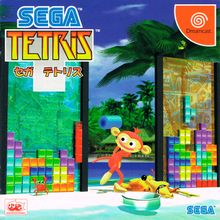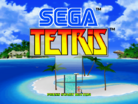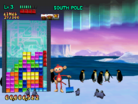Sega Tetris: Difference between revisions
| (11 intermediate revisions by 4 users not shown) | |||
| Line 18: | Line 18: | ||
'''''Sega Tetris''''' (セガテトリス ''Sega Tetorisu'') is a video game published by [[Sega]] for the NAOMI arcade platform and Dreamcast home consoles in Japan. It is reminiscent to Sega's earlier ''Tetris'' titles, featuring a similar rotation system, changing backgrounds, and a monkey as the primary mascot. | '''''Sega Tetris''''' (セガテトリス ''Sega Tetorisu'') is a video game published by [[Sega]] for the NAOMI arcade platform and Dreamcast home consoles in Japan. It is reminiscent to Sega's earlier ''Tetris'' titles, featuring a similar rotation system, changing backgrounds, and a monkey as the primary mascot. | ||
== Gameplay == | ==Gameplay== | ||
Despite the era in which the game was released, it has many design decisions that signal its [[Tetris (Sega)|1988 Sega Tetris]] heritage. The randomizer is pure random, and the original Sega Tetris [[power-on pattern]] makes an appearance during the credit roll. While the game does have both counter-clockwise and clockwise rotation buttons, it awards a massive point bonus for clearing the game using only counter-clockwise rotation. [[Wallkick]]s have been added, but they will only kick off of the literal left and right walls of the playfield rather than off of other pieces. | |||
===Single player=== | ===Single player=== | ||
| Line 24: | Line 25: | ||
===Battle mode=== | ===Battle mode=== | ||
There are 5 different attacks and they are available to you at all times by doing the specific line clear that triggers them. It is important to watch your opponent's playfield both offensively and defensively. You must plan which attacks will be most effective against them, and also learn what attack will soon be coming so that you can respond. | |||
{| class="wikitable" | {| class="wikitable" | ||
|- | |- | ||
! Triple | ! Line Clear | ||
| [[ | ! Attack | ||
! Description | |||
|- | |||
| Double | |||
| Joint Attack | |||
| The defending player must choose how to join two [[tetromino]]s in the next queue, and then place it in the playfield. The center of rotation is that of the base piece. | |||
|- | |||
| Triple | |||
| Special Long Block Attack | |||
| A single horizontal [[garbage]] line falls from the top. It will have a hole in the column that cleared the triple. | |||
|- | |- | ||
| Tetris | |||
| Four | | Upper Attack | ||
| Four [[garbage]] lines are sent. The garbage hole will be in the column that cleared the Tetris. | |||
|- | |- | ||
| Split Double | |||
| | | Missile Attack | ||
| Fire a missile that makes a T-spin shaped hole in the opponent's stack. It will aim somewhere high on the opponent's playfield. | |||
|- | |- | ||
| One-Two Split Triple | |||
| Knock opponent unconscious, | | K.O. Attack | ||
| Knock opponent unconscious, letting pieces fall slowly onto the stack. Pressing buttons quickly is required to wake up. | |||
|- | |- | ||
|} | |} | ||
==Bugs== | |||
There is a [[DAS]] bug when changing directions quickly. If there are no frames with neutral directional input, the game will preserve the [[DAS]] charge. This can cause [[misdrop]]s when you [[DAS]] to a wall and tap back once, only to find your piece [[DAS]] back several columns. This bug is confirmed to happen on original NAOMI arcade hardware using standard joystick controls and it was not fixed for the Dreamcast port. It can be avoided by slightly slowing your play to introduce one or more frames of neutral directional input. | |||
== UFO Catcher == | == UFO Catcher == | ||
| Line 66: | Line 79: | ||
===Dreamcast VS Cable=== | ===Dreamcast VS Cable=== | ||
The Dreamcast VS Cable allows you to connect two Dreamcast consoles together similar to a link cable, or crossover cable. It is one of only four games to support the Dreamcast VS Cable. | The Dreamcast VS Cable allows you to connect two Dreamcast consoles together similar to a link cable, or crossover cable. It is one of only four games to support the Dreamcast VS Cable. | ||
== Physical scans == | |||
{{Scanbox | |||
|console = Sega Dreamcast | |||
|region = JP | |||
|front = Sega_Tetris_boxart.jpg | |||
|back = Sega_Tetris_back_cover.jpg | |||
|square = | |||
|spinecard = Sega_Tetris_spine_card.jpg | |||
|disc = Sega_Tetris_disc.jpg | |||
|inlay = Sega_Tetris_inlay.jpg | |||
}} | |||
== See also == | == See also == | ||
* [[Sega Tetris/Translation]] | * [[Sega Tetris/Translation]] | ||
== References == | |||
<references /> | |||
== External links == | == External links == | ||
* [https://segaretro.org/Sega_Tetris ''Sega Tetris'' - segaretro.org] | * [https://segaretro.org/Sega_Tetris ''Sega Tetris'' - segaretro.org] - [https://web.archive.org/web/20190207002122/https://segaretro.org/Sega_Tetris Archive] | ||
* [ | * [https://web.archive.org/web/20200805204410/https://www.din.or.jp/~koryan/tetris/d-tst0.htm Koryan's basic data page] | ||
* [http://www.din.or.jp/~koryan/tetris/d-tst1.htm Koryan's single player data page] | * [https://web.archive.org/web/20200201054523/http://www.din.or.jp/~koryan/tetris/d-tst1.htm Koryan's single player data page] | ||
{{Sega games}} | {{Sega games}} | ||
Latest revision as of 01:00, 22 September 2024
- This article is about the 1999-2000 arcade and Dreamcast version. For the 1988 arcade version, see Tetris (Sega).
| Sega Tetris | |
|---|---|
 | |
| Developer(s) |
|
| Publisher(s) | Sega |
| Platform(s) | Sega NAOMI Sega Dreamcast |
| Release |
|
| Gameplay info | |
| Next pieces | 1 |
| Playfield size | 10 × 18 |
| Hold piece | No |
| Hard drop | No |
| Rotation system | Sega Rotation with wallkicks (Only kicks playfield's wall. Not the locked tetrominos.) |
Sega Tetris (セガテトリス Sega Tetorisu) is a video game published by Sega for the NAOMI arcade platform and Dreamcast home consoles in Japan. It is reminiscent to Sega's earlier Tetris titles, featuring a similar rotation system, changing backgrounds, and a monkey as the primary mascot.
Gameplay
Despite the era in which the game was released, it has many design decisions that signal its 1988 Sega Tetris heritage. The randomizer is pure random, and the original Sega Tetris power-on pattern makes an appearance during the credit roll. While the game does have both counter-clockwise and clockwise rotation buttons, it awards a massive point bonus for clearing the game using only counter-clockwise rotation. Wallkicks have been added, but they will only kick off of the literal left and right walls of the playfield rather than off of other pieces.
Single player
There are three available difficulties, easy, normal, and difficult. There is also an option to play with join block mechanic from the battle mode.
Battle mode
There are 5 different attacks and they are available to you at all times by doing the specific line clear that triggers them. It is important to watch your opponent's playfield both offensively and defensively. You must plan which attacks will be most effective against them, and also learn what attack will soon be coming so that you can respond.
| Line Clear | Attack | Description |
|---|---|---|
| Double | Joint Attack | The defending player must choose how to join two tetrominos in the next queue, and then place it in the playfield. The center of rotation is that of the base piece. |
| Triple | Special Long Block Attack | A single horizontal garbage line falls from the top. It will have a hole in the column that cleared the triple. |
| Tetris | Upper Attack | Four garbage lines are sent. The garbage hole will be in the column that cleared the Tetris. |
| Split Double | Missile Attack | Fire a missile that makes a T-spin shaped hole in the opponent's stack. It will aim somewhere high on the opponent's playfield. |
| One-Two Split Triple | K.O. Attack | Knock opponent unconscious, letting pieces fall slowly onto the stack. Pressing buttons quickly is required to wake up. |
Bugs
There is a DAS bug when changing directions quickly. If there are no frames with neutral directional input, the game will preserve the DAS charge. This can cause misdrops when you DAS to a wall and tap back once, only to find your piece DAS back several columns. This bug is confirmed to happen on original NAOMI arcade hardware using standard joystick controls and it was not fixed for the Dreamcast port. It can be avoided by slightly slowing your play to introduce one or more frames of neutral directional input.
UFO Catcher
UFO Catcher is a minigame available to play from the main menu. After earning virtual currency during regular gameplay, the player can spend it by playing this minigame to unlock playable characters.
The minigame works similarly to UFO catchers found in Japanese game centers.
- Press A to insert coin(s).
- Press Start to start the minigame.
- The player can look around with the directional buttons.
- The player presses and holds A to move the arm right. Once they let go they can no longer move it left or right.
- The player presses and holds A a second and last time to move the arm away from them.
- The arm then descends and grabs.
- If the player succeeded in catching a prize, it is added to their collection which can be viewed by pressing X.
Completing various challenges in Sega Tetris, will add new characters to the UFO Catcher minigame. They will only be playable if the player catches them in the minigame.
Connectivity
Sega Tetris supports a few of the connectivity options on the Dreamcast. When connecting to the internet or VS Cable to play, up to 4 players are supported.
Net play
As of November 30, 2002, Net play is no longer supported.[1]
Dreamcast VS Cable
The Dreamcast VS Cable allows you to connect two Dreamcast consoles together similar to a link cable, or crossover cable. It is one of only four games to support the Dreamcast VS Cable.
Physical scans
See also
References
External links
| |||||||||||





